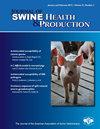生物样品预分析操作对脂溶性维生素分析的影响
IF 0.7
4区 农林科学
Q3 Agricultural and Biological Sciences
引用次数: 1
摘要
目的:确定样品处理如何影响脂溶性维生素和矿物质的营养分析。材料和方法:在实验1中,将血液收集在血浆或血清血管中,并暴露于光照4小时或用铝箔包裹以避光。在实验2中,在食用饲料后的第0、1、2、3、4、6和12小时采集血液。在实验3中,在不同程度的溶血血液样本中评估维生素和矿物质。实验4评估了暴露在不同温度下长达12小时的肝脏样本。在实验5中,血清和肝脏样本在采集后第天、采集后第1天或采集后第2天进行处理,随后放入装有冰袋的冷却器中。结果:维生素D(25-羟基维生素D3)的管型和光暴露的相互作用有显著差异(P<0.05),维生素a(视黄醇)的管式和光暴露相互作用有趋势(P<.10)。实验2发现,饲料消耗后血清维生素浓度呈线性和二次型变化。α-生育酚在餐后4小时达到峰值,而视黄醇在6小时达到峰值。在实验3中,溶血程度影响(P<0.05)营养物浓度。实验4和5显示在视黄醇和α-生育酚的降解方面没有差异(P>0.05)。含义:由于许多预分析因素会影响实验室结果,因此在收集、处理和储存用于维生素和矿物质诊断分析的样本时必须小心。本文章由计算机程序翻译,如有差异,请以英文原文为准。
Influence of biological sample pre-analytical manipulation for fat-soluble vitamin analysis
Objective: Determine how sample handling affects nutrient analysis of fat-soluble vitamins and minerals. Materials and methods: In experiment 1, blood was collected in either plasma or serum blood tubes and exposed to 4 hours of light or wrapped in aluminum foil to protect from light. In experiment 2, blood was collected at hours 0, 1, 2, 3, 4, 6, and 12 after the consumption of feed. In experiment 3, vitamins and minerals were assessed in varying degrees of hemolyzed blood samples. Experiment 4 evaluated liver samples exposed to various temperatures for up to 12 hours. In experiment 5, serum and liver samples were processed the day of, 1 day after, or 2 days after collection and subsequent placement into coolers with icepacks. Results: There was a significant difference (P < .05) for the interaction of tube type and light exposure for vitamin D (25-hydroxyvitamin D3) and a tendency (P < .10) for a tube type and light exposure interaction for vitamin A (retinol). Experiment 2 found serum vitamin concentrations changed post feed consumption both linearly and quadratically. Alpha-tocopherol peaked at 4 hours post meal consumption, whereas retinol peaked at 6 hours. In experiment 3, the degree of hemolysis affected (P < .05) nutrient concentration. Experiment 4 and 5 showed no differences (P > .05) in degradation of retinol and alpha-tocopherol. Implication: As many pre-analytical factors can affect laboratory results, care must be taken when collecting, handling, and storing samples for diagnostic analysis of vitamins and minerals.
求助全文
通过发布文献求助,成功后即可免费获取论文全文。
去求助
来源期刊
CiteScore
1.80
自引率
0.00%
发文量
29
审稿时长
>36 weeks
期刊介绍:
The Journal of Swine Health & Production (JSHAP) is an open-access and peer-reviewed journal published by the American Association of Swine Veterinarians (AASV) since 1993. The aim of the journal is the timely publication of peer-reviewed papers with a scope that encompasses the many domains of applied swine health and production, including the diagnosis, treatment, management, prevention and eradication of swine diseases, welfare & behavior, nutrition, public health, epidemiology, food safety, biosecurity, pharmaceuticals, antimicrobial use and resistance, reproduction, growth, systems flow, economics, and facility design. The journal provides a platform for researchers, veterinary practitioners, academics, and students to share their work with an international audience. The journal publishes information that contains an applied and practical focus and presents scientific information that is accessible to the busy veterinary practitioner as well as to the research and academic community. Hence, manuscripts with an applied focus are considered for publication, and the journal publishes original research, brief communications, case reports/series, literature reviews, commentaries, diagnostic notes, production tools, and practice tips. All manuscripts submitted to the Journal of Swine Health & Production are peer-reviewed.

 求助内容:
求助内容: 应助结果提醒方式:
应助结果提醒方式:


